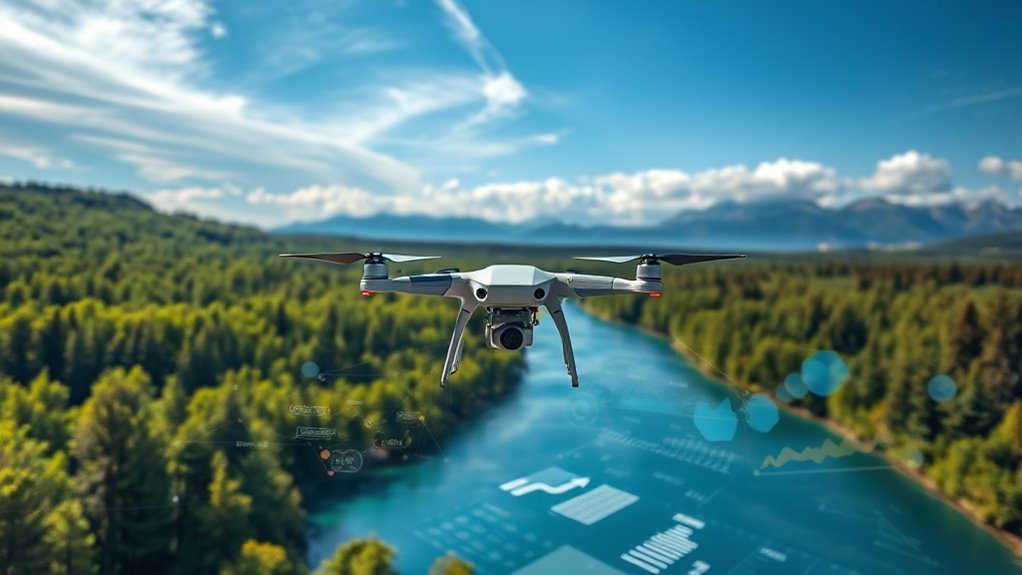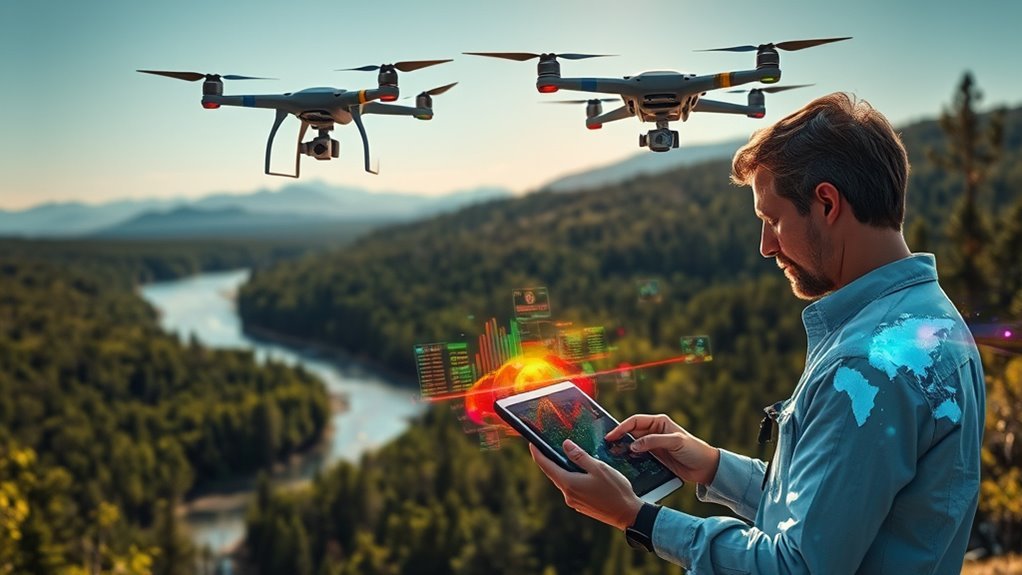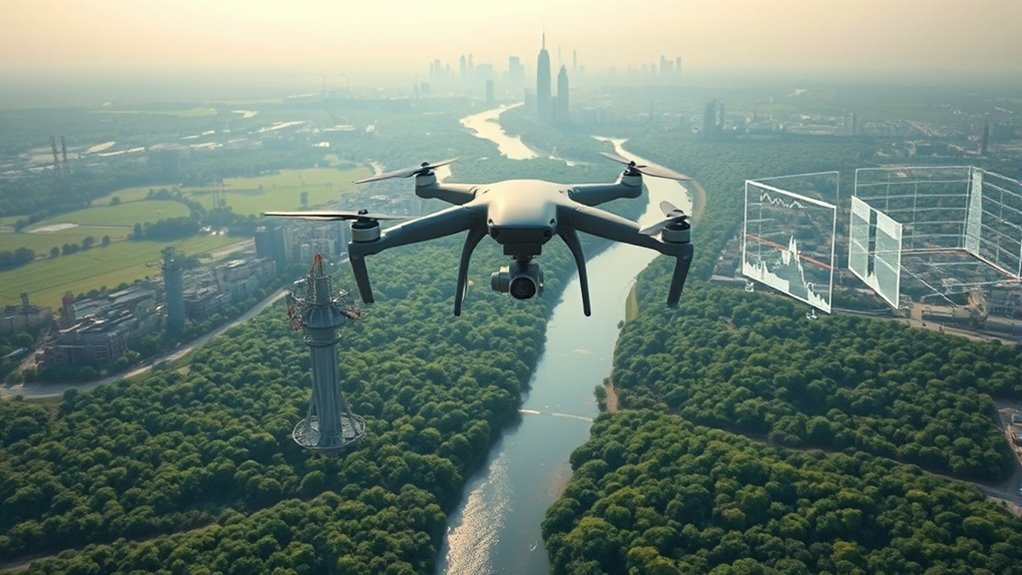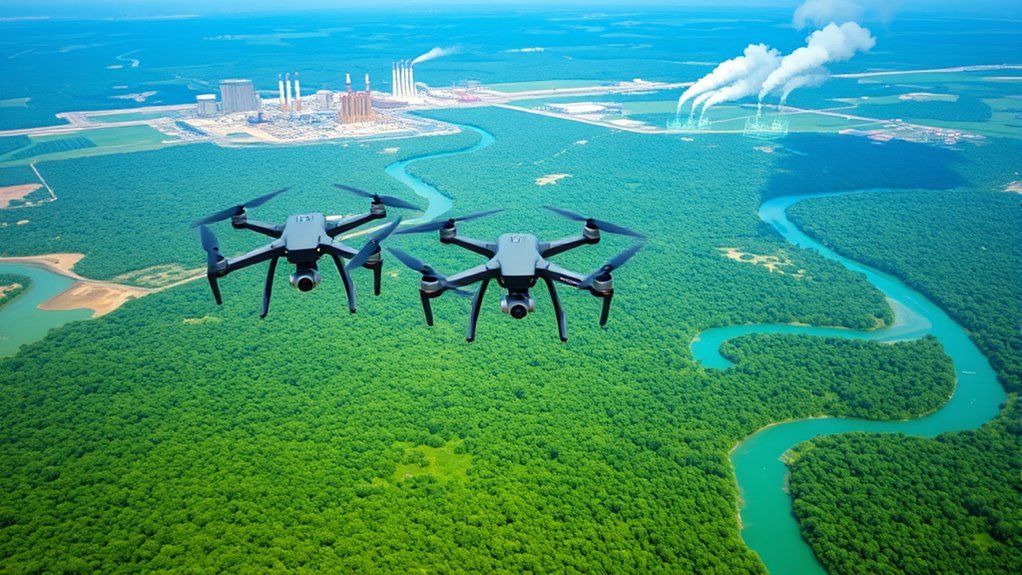You can use AI to monitor the environment and predict pollution by analyzing real-time data from sensors, satellites, and IoT devices. Machine learning algorithms like Random Forests and Neural Networks identify pollution patterns and forecast changes in air, water, and soil quality with high accuracy. AI also integrates diverse data sources to improve detection and enable timely interventions. Understanding these technologies reveals how AI drives precision and efficiency in environmental protection efforts.
The Role of AI in Modern Environmental Science

While traditional methods of environmental monitoring have relied heavily on manual data collection and analysis, AI has transformed this landscape by enabling real-time processing of vast datasets from sensors, satellites, and IoT devices. You can now leverage AI algorithms to detect subtle shifts in environmental indicators, allowing for early intervention to maintain ecological balance. This precision supports sustainable practices by optimizing resource use and minimizing waste, ensuring ecosystems remain resilient. By automating data interpretation, AI eliminates delays and human errors, giving you immediate insight into pollution patterns and habitat changes. This empowers you to make informed decisions that uphold environmental integrity while preserving your freedom to innovate and act swiftly. AI’s role in modern environmental science is therefore pivotal in integrating technology with conservation goals.
Key Technologies Behind AI-Based Environmental Monitoring

Cutting-edge technologies like machine learning, remote sensing, and IoT form the backbone of AI-based environmental monitoring. Remote sensing provides high-resolution, real-time data on land, water, and atmospheric conditions, enabling you to track environmental changes with precision. Machine learning algorithms analyze this data, identifying patterns and predicting pollution trends effectively. Ecological modeling integrates these insights, simulating ecosystem responses to various stressors, empowering you to make informed decisions. IoT devices continuously collect localized environmental data, enhancing monitoring accuracy. Together, these technologies enable a dynamic, scalable monitoring system that adapts to complex ecosystems without restricting your analytical freedom. By harnessing this tech trio, you gain the capacity to proactively detect environmental threats and optimize intervention strategies, ensuring sustainable ecosystem management grounded in robust, data-driven intelligence.
Data Sources Utilized in Pollution Prediction Models

Building on the technologies that power AI-based environmental monitoring, the accuracy of pollution prediction models heavily depends on the quality and diversity of data sources they utilize. You’ll find that integrating satellite imagery offers expansive, real-time insights into pollutant dispersion and land-use changes, essential for precise spatial analysis. Additionally, social media data provides a unique, ground-level perspective by capturing user-generated reports and environmental anomalies, enriching the dataset with temporal and localized pollution events. Combining these heterogeneous sources enhances model robustness, enabling you to detect patterns that single-source data might miss. The fusion of remote sensing and crowd-sourced information empowers you to develop pollution predictions that are both thorough and adaptive, aligning with your need for freedom in data-driven environmental decision-making.
Machine Learning Algorithms for Detecting Pollution Patterns
As you analyze complex environmental data, selecting the right machine learning algorithms is essential for accurately detecting pollution patterns. Effective pollution detection hinges on pattern recognition capabilities tailored to diverse data types. Algorithms like Random Forests, Support Vector Machines (SVM), and Neural Networks excel in identifying subtle correlations within noisy datasets, empowering you to reveal hidden pollution trends.
| Algorithm | Strength in Pollution Detection |
|---|---|
| Random Forest | Handles high-dimensional data well |
| Support Vector Machine | Effective in clear boundary classification |
| Neural Networks | Captures complex nonlinear patterns |
| K-Nearest Neighbors | Simple, interpretable pattern recognition |
| Gradient Boosting | High accuracy with imbalanced data |
Choosing the right model lets you disclose precise insights, driving informed decisions in environmental monitoring. Employing iterative refinement techniques can further enhance the accuracy and relevance of pollution detection models.
Real-Time AIr Quality Monitoring With AI
You’ll need to integrate diverse sensors capturing pollutants, temperature, and humidity to gather accurate real-time data. Then, advanced algorithms process this influx, filtering noise and identifying meaningful trends instantly. Finally, predictive models use this processed data to forecast air quality changes, enabling proactive environmental responses.
Sensor Integration Techniques
Although integrating sensors for real-time air quality monitoring presents technical challenges, it’s vital for accurate environmental assessment. You need to apply robust sensor calibration methods to guarantee each device delivers reliable data despite environmental variability and sensor drift. Calibration aligns sensor outputs with reference standards, maintaining data integrity over time. Additionally, sensor fusion techniques play an important role by combining data from multiple sensors, enhancing spatial and temporal resolution. This multi-source integration reduces noise and compensates for individual sensor limitations, granting you a thorough understanding of pollution dynamics. By carefully selecting and synchronizing sensors, you achieve a resilient network capable of capturing subtle fluctuations in air quality. These integration strategies empower you with precise, actionable insights essential for informed environmental decision-making.
Data Processing Algorithms
When processing real-time air quality data, effective algorithms must handle vast, heterogeneous inputs swiftly to deliver accurate insights. You’ll rely on data normalization techniques to standardize disparate sensor outputs, ensuring consistency and comparability. Algorithm optimization strategies are essential to reduce latency and computational load without sacrificing precision. This balance lets you maintain freedom in adapting systems to evolving environmental variables.
Key components include:
- Implementing robust data normalization techniques for sensor variance correction
- Applying algorithm optimization strategies to enhance processing speed
- Utilizing parallel processing to manage data influx efficiently
- Incorporating adaptive filtering to reduce noise and improve signal clarity
Predictive Air Quality Models
Since environmental conditions shift rapidly, predictive air quality models leverage AI to forecast pollutant levels with high temporal and spatial resolution. You can access real-time air quality forecasting that integrates vast datasets—meteorological variables, emission sources, and historical pollution trends—to predict pollution impact accurately. These models use machine learning algorithms to identify complex patterns and correlations that traditional methods often miss, enabling proactive responses. By relying on AI-driven predictions, you gain the freedom to anticipate hazardous air quality episodes before they occur, optimizing public health interventions and regulatory decisions. This precision in forecasting helps minimize exposure risks and informs sustainable urban planning, ensuring cleaner air. Ultimately, predictive air quality models empower you to make data-driven choices that safeguard environmental and personal well-being.
Predicting Water Contamination Using Artificial Intelligence
As water quality becomes an increasingly critical concern, artificial intelligence offers powerful tools to predict contamination events with greater accuracy and speed. By integrating vast datasets, AI enhances water quality assessment, enabling you to detect anomalies early and identify pollution sources precisely. Machine learning models analyze chemical, physical, and biological indicators, forecasting contamination risks before they escalate. This proactive approach supports timely interventions and resource allocation.
- Real-time monitoring with sensor data integration
- Advanced analytics for pollution source identification
- Predictive models based on historical and environmental variables
- Automated alerts for potential contamination events
Using AI, you gain freedom from reactive management, empowering data-driven decisions that safeguard water resources efficiently and transparently. Leveraging cloud scalability allows these AI systems to dynamically adjust computing resources to handle complex environmental data in real-time.
Soil Pollution Analysis and Forecasting Techniques
Although soil pollution often goes unnoticed compared to air and water contamination, its impact on ecosystems and human health is profound and measurable. You can leverage advanced monitoring techniques to track pollution indicators, identifying contamination sources with high precision. Predictive analytics enable you to forecast soil health degradation, evaluating agricultural impact and ecosystem evaluation effectively. By integrating data from sensors and satellite imagery, you gain a thorough risk evaluation framework to inform remediation strategies. These insights support policy implications aimed at sustainable land management. Embracing AI-driven soil pollution analysis empowers you to make data-driven decisions, balancing freedom in land use with environmental responsibility. This approach not only safeguards soil integrity but also enhances long-term ecological resilience and human well-being.
Case Studies: Successful AI Applications in Environmental Protection
When you examine real-world examples, it becomes clear how AI is transforming environmental protection through precise data analysis and predictive modeling. These case studies highlight AI solutions driving significant environmental advancements by leveraging monitoring innovations and predictive analytics to track pollution trends accurately. You’ll notice technology impacts that not only optimize resource use but also enable proactive intervention before ecological damage escalates. Here are four success stories illustrating AI’s role:
- AI-powered satellite data predicting air quality changes in urban areas
- Machine learning models forecasting water contamination events
- Automated wildlife monitoring reducing poaching risks
- Deep learning algorithms identifying illegal deforestation patterns
These instances prove that embracing AI fosters freedom to act decisively, turning data into actionable insights for sustainable environmental management.
Challenges and Future Directions in AI-Powered Pollution Prediction
You’ll face significant hurdles with inconsistent data quality, which directly impacts model accuracy and reliability in pollution prediction. Scaling AI systems to handle the vast spatial and temporal variability of environmental data remains a complex challenge. Additionally, integrating these AI tools into existing monitoring frameworks requires standardized protocols and seamless interoperability.
Data Quality Issues
Since AI models rely heavily on the quality of input data, any inaccuracies or inconsistencies in environmental datasets can greatly compromise pollution predictions. You need to prioritize data accuracy through rigorous sensor calibration and continuous data validation. Measurement consistency guarantees that temporal resolution and spatial coverage align, providing a reliable foundation for AI algorithms. Bias mitigation is essential, especially when integrating heterogeneous data sources with varying dataset diversity. Anomaly detection helps identify outliers that could skew results, maintaining model integrity.
Key focus areas include:
- Guaranteeing sensor calibration and measurement consistency
- Implementing robust data validation and anomaly detection
- Enhancing dataset diversity through thorough spatial coverage
- Balancing temporal resolution to capture dynamic pollution patterns
Addressing these data quality issues empowers you to develop precise, unbiased pollution prediction models.
Scalability and Integration
Although AI-powered pollution prediction models have advanced in accuracy, scaling these solutions to broader geographic regions and integrating them within existing environmental monitoring systems present significant challenges. You’ll find that developing scalable solutions requires handling diverse data sources with varying formats and quality, which complicates model generalization. Integration challenges arise from legacy systems lacking compatibility with modern AI architectures, demanding substantial customization and interoperability frameworks. To overcome these barriers, you must prioritize modular AI components that adapt to different environmental contexts and support real-time data ingestion. Additionally, fostering open standards and collaborative platforms can streamline integration efforts. Addressing scalability and integration is essential if you want AI to truly empower environmental monitoring, enabling more thorough, timely pollution predictions across varied ecosystems without sacrificing model reliability or operational efficiency.



